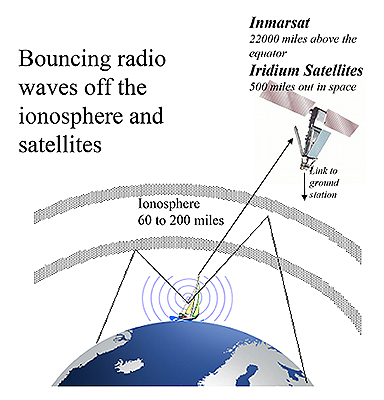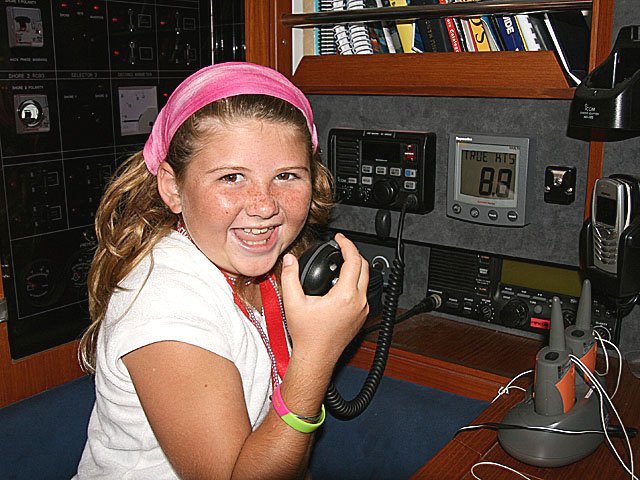Staying connected is important both for safety of boats at sea and for the social interaction between crews that adds another level to the enjoyment of sailing offshore. During ocean stages of our rallies there are daily SSB (HF) radio nets, which are a mix of safety messages, discussions on weather and routing, and social contact between the boat crews.
What is SSB (HF) Radio?
High Frequency (HF) radio, often referred to in the UK and USA by the initials “SSB” (which stand for Single-Side-Band) is a type of radio that operates on specific short-wave (HF) frequencies reserved for marine use and provides voice communication over long distances. SSB Radio and satellite telephone systems, such as Iridium, both use radio waves to provide their connection - the key difference with SSB radio is that the signal is bounced (or skipped in radio-speak) off the earth’s atmosphere (the part called the ionosphere) to achieve long range. A satellite system also “bounces” radio signals but via an orbiting satellite, rather than the ionosphere. A short range VHF (very high frequency) radio does not use the bounce effect – it is only viable as far as the signal can travel in a straight line, which is effectively line-of-sight.
Why have SSB (HF) Radio?This is a question often asked by prospective rally skippers. The key benefit of SSB radio is the ability to communication directly with the whole fleet at one time. This is what previous rally skippers have said about the benefits to them of using SSB radio, both for safety and social support.
“
When I had my rudder emergency I called eight other boats by sat-phone and got no replies; it wasn’t until the next radio net that I was able to share the problem with fleet, and start getting the useful advice I needed to help me through the problem, and give me much appreciated support.”
Mark – Mad Monkey
Don’t underestimate the importance of wider social contact with other crews whilst at sea. The distances involved in crossing an ocean on a small boat can make you feel vulnerable and isolated. Being able to chat freely with other crews helps break down these feelings. This is how Hal from Cayuse described it. “SSB is the only way to communicate in real time on a daily basis. The radio net breaks the day up, and adds interest to the day. Talking on SSB is much better than communicating by e-mail.”
Another, less well-known benefit of SSB radio is that it fitted to all commercial ships as part of the global safety net (GMDSS). If an emergency occurs at sea, the GMDSS distress function “red button” will aid communication with commercial shipping in your area.
Data ConnectionsIf you are planning long-term live-aboard cruising, then fitting a pactor modem to the SSB radio is a popular option. This extra add-on enables your standard radio to make encoded digital connections via a land station to send and receive email. Unlike satellite systems there are no airtime charges to use radio email, just an annual subscription. However, there are some significant downsides to the radio-email which need to be considered when making an equipment choice. Firstly it is a “single-user” system, which means that only one boat can use a specific frequency to connect to the land-station at any one time. Given that the connection frequency is determined by location and time of day (called “radio propagation”) this can lead to long waits to make a connection. Whilst there are programs for your laptop designed to work with radio-email and make the process easier, it is definitely true that using radio-email requires greater operator skill than a satellite connection. Plus the purchase cost for the pactor modem adds further to your equipment set-up bill.
Communications Requirements for WCC Rallies
Rally boats are required to have:
- EPIRB - an emergency beacon transmitting on 406MHz and 121.5MHz or AIS
- AIS transponder – the AIS (Automatic Identification System) enables vessels nearby to know your boat name, course and speed. All crew members need a personal AIS beacon fitted to their lifejacket.
- MMSI number – this will be provided via your national radio licensing authority and is unique to your vessel. When used with the DSC (Digital Selective Calling) function on radios, it allows a direct vessel-to-vessel call, similar to dialling a telephone number. DSC works on VHF and HF (SSB) radios. Your MMSI is also programmed into your AIS transceiver.
- Fixed VHF radio with DSC – used for short range (10NM) communications between vessels and to shore. With external cockpit speaker and an emergency antenna.
- Handheld VHF radio - waterproof, preferably with DSC and GPS.
- Email at sea – you need to have a satcomms system for sending and receiving email at sea, or an SSB radio with a Pactor modem (not for ARC Portugal as this is a coastal rally). World ARC boats only: a DSC capable SSB HF radio transciver or a suitable satcomms system capable for transmitting and continually monitoring an instant messaging app.
- We also require boats to have more traditional communications equipment like pyrotechnic or electronic flares and a high powered search light.
- Satellite tracker – these are provided for you by World Cruising Club as a rally benefit. The YB Trackers provide the exact positions of all the boats, which are displayed on the rally website and YB Races aoo. The YB trackers also have a two-way messaging function that enables crew to stay connected with family and friends.
Radio Nets Around the WorldLearning to love your SSB radio will open up a world of information pass on via cruisers radio nets – these are informal groups that meet at a consistent time and on a published frequency to share information. There is usually a controller who directs the net, but anyone can join in, as they are run by cruisers for cruisers. Weather and security messages are shared and often cruisers will use the nets as a way to keep in contact with friends. Radio Nets tend to be regional and are popular in areas with lots of live-aboard cruisers, such as the Caribbean and the Sea of Cortez. Perhaps the best known in the Caribbean is the “Caribbean Maritime Mobile Net” run by George Kline operates this daily weather net (except Sundays) at 1100 UTC on 7250 LSB. Whilst this is a "HAM" net, anyone can listen. For more information on cruiser radio nets visit
noonsite - the cruiser's planning tool.